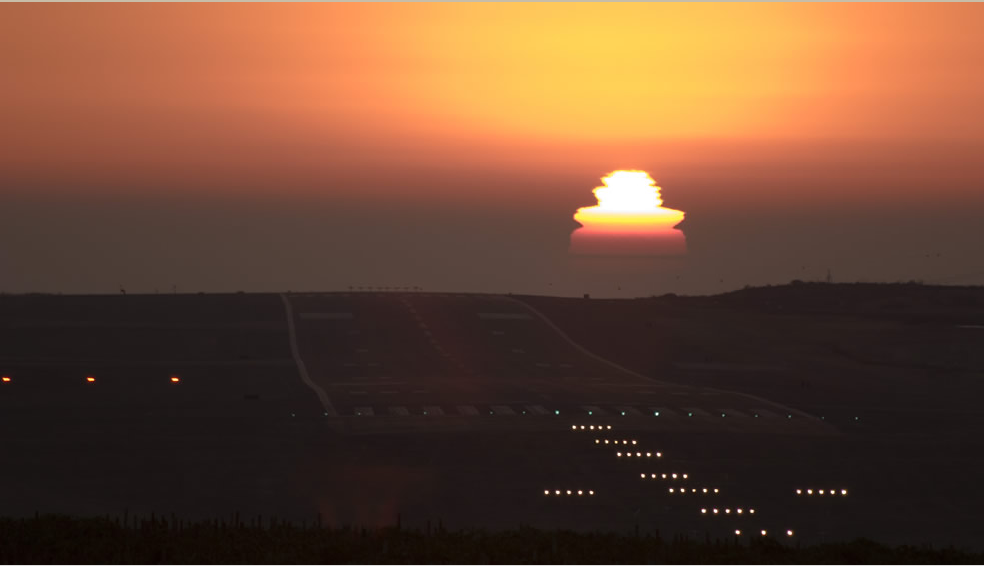Carlsbad California M-Mir Sunset
Carlsbad California M-Mir Sunset: A Spectacular Atmospheric Phenomenon
Witnessing a breathtaking sunset is always a memorable experience, but some sunsets go beyond the ordinary. One such remarkable occurrence took place in Carlsbad, California, on October 13, 2005. Kevin Baird, an avid observer of atmospheric optics, captured a mesmerizing sight known as the Southern California Mock-Mirage Sunset. This event showcased an impossibly distorted sun, creating a dark red fade instead of the anticipated green flash. Let's delve into the fascinating world of atmospheric optics and explore the intricacies behind this captivating phenomenon.
Atmospheric mirages, like the one witnessed by Baird, occur when light rays pass through layers of air with varying temperatures and densities. These temperature and density gradients cause the rays to bend, resulting in the distortion of objects seen through them. In the case of the Carlsbad M-Mir Sunset, multiple inversion layers played a significant role in producing this complex mirage.
The first layer of inversion was created by the cold California Ocean Current, which had cooled the air adjacent to the ocean surface. Above this cool layer, warm and dry air from inland areas, driven by high pressure over Utah and Nevada, formed additional inversion layers. The combination of these inversions created an intricate atmospheric setup that led to the remarkable mirage observed by Baird.
To fully appreciate the uniqueness of this event, it is essential to understand the concept of a mock-mirage. A mock-mirage occurs when the inverted image of an object appears above its actual position. This optical illusion is caused by a temperature inversion that bends light rays downward towards the ground before they reach the observer's eye. In the case of the Carlsbad M-Mir Sunset, this effect resulted in an elongated and distorted sun appearing lower on the horizon than it actually was.
The mirage observed by Baird also displayed characteristics of a superior mirage, a phenomenon that occurs when the light rays curve upward due to a strong temperature inversion. This bending of light causes objects to appear higher in the sky than their true position. In the case of the Carlsbad sunset, the superior mirage effect further contributed to the distorted and elongated appearance of the sun.
The intricate interplay between temperature inversions, superior mirages, and mock-mirages created a truly awe-inspiring spectacle in Carlsbad that evening. As the sun descended towards the horizon, its image became increasingly distorted and elongated. The dark red fade observed by Baird instead of the anticipated green flash was a result of the murky sky caused by multiple inversion layers.
The occurrence of such a unique mirage highlights the dynamic nature of our atmosphere and its ability to produce captivating optical phenomena. Atmospheric optics is a fascinating field that continues to amaze scientists and enthusiasts alike. By studying these phenomena, we gain a deeper understanding of the complex interactions between light and the atmosphere, shedding light on the secrets hidden within our skies.
In conclusion, the Carlsbad California M-Mir Sunset stands as a testament to the wonders of atmospheric optics. This mesmerizing event showcased a distorted and elongated sun, creating a dark red fade instead of the expected green flash. Through a combination of temperature inversions, superior mirages, and mock-mirages, this unique spectacle captivated observers and highlighted the intricate workings of our atmosphere. As we continue to explore and study atmospheric optics, we unlock the mysteries of our skies and gain a greater appreciation for the beauty that lies beyond our reach.

Southern California Mock-Mirage Sunset. Kevin Baird (images) saw this impossibly distorted sun on October 13, '05 from near Palomar Airport . "I watched for a green flash, but the sky became so murky toward the horizon that the sun almost disappeared. More of a dark red fade than a green flash." Multiple inversion layers produced the complex mirage. The cold California Ocean Current had cooled the air next to the ocean surface. Above that there were layers of warm dry air driven from inland by high pressure over Utah and Nevada. Image ©Kevin Baird, shown with permission.
Note: this article has been automatically converted from the old site and may not appear as intended. You can find the original article here.
Reference Atmospheric Optics
If you use any of the definitions, information, or data presented on Atmospheric Optics, please copy the link or reference below to properly credit us as the reference source. Thank you!
-
<a href="https://atoptics.co.uk/blog/carlsbad-california-m-mir-sunset/">Carlsbad California M-Mir Sunset</a>
-
"Carlsbad California M-Mir Sunset". Atmospheric Optics. Accessed on April 16, 2024. https://atoptics.co.uk/blog/carlsbad-california-m-mir-sunset/.
-
"Carlsbad California M-Mir Sunset". Atmospheric Optics, https://atoptics.co.uk/blog/carlsbad-california-m-mir-sunset/. Accessed 16 April, 2024
-
Carlsbad California M-Mir Sunset. Atmospheric Optics. Retrieved from https://atoptics.co.uk/blog/carlsbad-california-m-mir-sunset/.